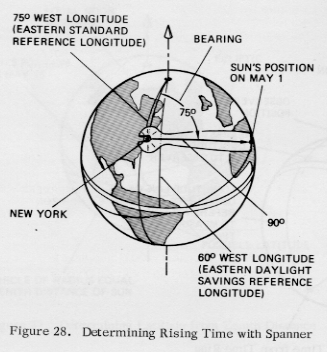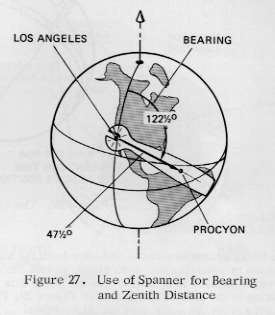|
USE OF THE SPANNER TO MEASURE BEARING AND ZENITH DISTANCE (DIRECTION COORDINATES) OF CELESTIAL OBJECTS The Uniglobe and its spanner may be used to determine direction coordinates, a more precise process than shown in Figure 26. With the two globes oriented for the current date and time as described previously, two definitve position coordinates may be measured with the spanner as shown in Figure 27. To measure zenith distance to a celestial object place the spanner rosetta over the observation position, and the cursor line over the celestial object. The zenith distance from the position on the earth globe to the celestial object's position is measured directly on the spanner. For example, the zenith distance from Los Angeles to Procyon on May 1st at 1400 hours (Pacific Standard Time) is 47 1/2°. To measure bearing to a celestial object, at a given time, read the angle from the roesetta between the cursor line and north. For example, with the conditions shown, the bearing from north to Procyon at Los Angeles is 112 1/2° E of N or 22 1/2° S of E.
TRANSIT TIME It is possible to determine the time at which a celestial object is either due north or south of a given obeservation point. (This is called the TRANSIT TIME). This is accomplished by setting up the two glboes for the specific date and measuring the time that a specific celestial object passes through the meridian of the observation point. For example, the transit time of Rigel at Mexico City on May 1 is 1500 CST (note that Rigel will not be visible at transit because it is still daylight). Mexico City uses the time of the 90° standard longitude.  |
 RISING AND SETTING TIMES The rising and setting times of a celestial object can be determined for a specific observation point. The rising time of an object is that time when the object rises above the horizon in the East for a specific observation point (Zenith distance 90°). The setting time is that time when the object disappears over the horizon in the West (Zenith Distance 90°). See Figure 28. To determine the rising time of the sun as seen from New York on May, place the spanner rosetta on New York, and rotate the celestial sphere until the 90° mark on the spanner cursor intersects the position of the sun on May 1 east of New York. The local Mean Standard Time can then be read directly on the time ring at 75° W meridian as 0505 EST. Since New York would be on Daylight Savings time, the time at longitude 60° W would be sued, or 0605 EDST. The bearing of the sun when it rises is approximately 15° N of E. The sun at that time is directly overhead in Sudan, and almost due south of Helsinki, Finland. The sun's setting time in New York on May 1 (90° Zenith Distance) is 1930 EDST or 7:30 P.M. EXERCISE Determine rising time of Deneb on May 1, as seen in Jamaica (2250 EST). When Deneb is just rising in Jamaica, it is 18° above the horizon in New York. |
|
Page 15 |